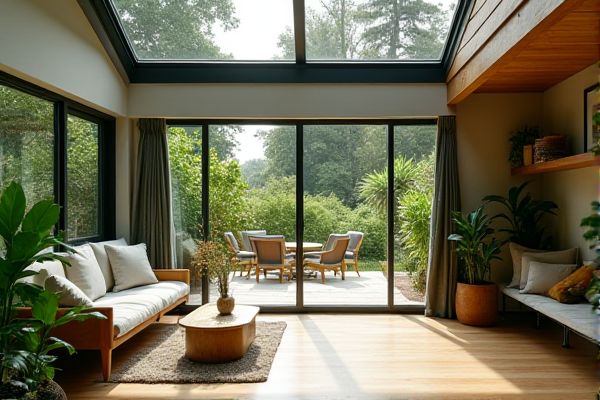
Leaf extension and butterfly extension are two methods used to enhance natural beauty, where leaf extensions focus on adding hair strands that resemble leaves for a more organic look, while butterfly extensions use lightweight, wing-shaped attachments for volume and length without damage. Explore the rest of the article to discover which extension technique suits your style and hair type best.
Table of Comparison
| Feature | Leaf Extension | Butterfly Extension |
|---|---|---|
| Design | Flat, single-plane structure | Folded, multi-panel structure resembling butterfly wings |
| Installation | Simple, mounts on one side | Complex, requires multiple hinges and panels |
| Space Efficiency | Less efficient, occupies more space when extended | More efficient, folds compactly |
| Usage | Commonly used for small extensions or desks | Ideal for larger tables, maximizing extension surface |
| Durability | Stable but limited support | Strong support due to multiple points of contact |
| Cost | Generally lower cost | Higher cost due to complexity |
Introduction to Leaf Extension and Butterfly Extension
Leaf extension offers a streamlined design ideal for space-saving and seamless surface expansion, enhancing dining or workspace flexibility with its hinged mechanism. Butterfly extension features a foldable, double-panel system that unfolds in a distinctive butterfly shape, providing quick and easy table enlargement with balanced support. Both extensions optimize usability and aesthetic appeal but differ in mechanism and space requirements, catering to various functional preferences.
Definition and Core Concepts
Leaf extension refers to a hairstyle technique where synthetic or natural hair pieces shaped like thin, flat leaves are attached to your natural hair, creating volume and length with a lightweight feel. Butterfly extensions utilize small, delicate strands designed to mimic the shape and flutter of butterfly wings, offering a more intricate and dynamic texture that blends seamlessly with your hair. Both methods enhance hair appearance but differ in shape, application, and the distinct effect they create.
Design and Structural Differences
Leaf extensions feature a solid, tapered design that enhances vehicle aerodynamics and provides a sleek, continuous look, while butterfly extensions use hinged panels that open outward, offering easier access to the truck bed. Structurally, leaf extensions rely on rigid mounting points and seamless integration with the tailgate, whereas butterfly extensions incorporate pivot mechanisms and reinforced hinges for durability under repeated use. Your choice depends on whether you prioritize streamlined appearance or functionality in loading and unloading.
Materials and Build Quality
Leaf extensions are typically crafted from solid wood or engineered wood, offering durability and a sturdy build quality that supports heavy table settings. Butterfly extensions, often made from matching veneer or hardwood, feature a hinged design that folds underneath the table, prioritizing space-saving without compromising on strength. Understanding the materials and construction ensures you choose the extension best suited for your table's longevity and your hosting needs.
Space-Saving Advantages
Leaf extensions offer space-saving advantages by seamlessly folding into the table, allowing you to expand or reduce the surface area without bulky add-ons. Butterfly extensions are designed with a compact folding mechanism hidden beneath the tabletop, which maximizes space efficiency when not in use. Your choice depends on the balance between convenience and the available storage area for the extensions.
Functionality and Ease of Use
Leaf extensions provide seamless table expansion with minimal effort, ideal for formal dining or workspaces requiring extra surface area. Butterfly extensions fold neatly under the table when not in use, offering excellent space-saving functionality but can be more complex to deploy. Your choice depends on prioritizing quick usability with leaf extensions or compact storage with butterfly extensions.
Aesthetic and Visual Appeal
Leaf extensions create a natural, delicate look with tapered ends mimicking real foliage, enhancing hair textures and offering subtle volume. Butterfly extensions provide a bolder, multidimensional appearance with vibrant color contrasts and intricate patterns, attracting attention with their dramatic flair. Both styles serve distinct aesthetic purposes, catering to either understated elegance or vivid, eye-catching designs.
Cost and Budget Considerations
Leaf extensions typically offer a more budget-friendly option, as they are designed for quick installation and use fewer materials. Butterfly extensions often come with a higher price tag due to their intricate design and the specialized techniques required for application. Your choice should consider both initial costs and long-term maintenance expenses to ensure it aligns with your budget.
Popular Applications and Use Cases
Leaf extensions are popular in interior design for creating large, expandable dining tables and conference tables, offering seamless surface continuity and easy adjustment for varying guest numbers. Butterfly extensions are favored in residential settings due to their compact folding mechanism, making them ideal for smaller spaces and quick, convenient table size adjustments. Your choice depends on whether you prioritize elegant, smooth expansions or space-saving, user-friendly functionality.
Choosing the Right Extension: Leaf vs Butterfly
Choosing between leaf and butterfly extensions hinges on the intended purpose and design requirements of the project. Leaf extensions are ideal for streamlined, flat surfaces, offering structural support with minimal visual impact, while butterfly extensions provide intricate, decorative elements suited for ornamental and dynamic designs. Evaluating factors like aesthetic preference, load-bearing needs, and installation environment ensures the optimal extension type enhances both functionality and visual appeal.
 homyna.com
homyna.com